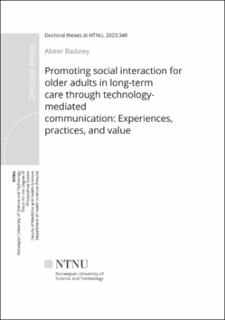| dc.description.abstract | Technology-mediated communication has played a crucial role in maintaining social contact between older adults and their friends and relatives, despite health-related disabilities. However, the COVID-19 pandemic has compelled individuals to limit face-to-face interaction due to social distancing measures by healthcare authorities worldwide. As a result, the lives of older people have been significantly affected, leading to increased feelings of loneliness and social isolation. Consequently, municipalities and informal caregivers have introduced digital communication technologies in long-term care settings and private homes. Despite the growing trend, there is still little knowledge about the experiences and practices of healthcare professionals, older people, and their relatives regarding digital communication technology, and how it has impacted their daily social lives during the pandemic’s social distancing measures.
This thesis explores the experiences of older residents, their relatives, and healthcare professionals regarding the use of digital communication technology. It also examines practices employed to facilitate and promote social contact between older people residing in long-term care homes and their relatives in western Norway during the pandemic. The thesis consists of three qualitative studies. The first study is an exploratory one that examines how and why healthcare professionals facilitated the rapid adoption of communication technology in longterm care facilities during the pandemic. The second study is a case study that discusses the normalisation of technology-related practices to maintain social contact between older residents and their relatives, and whether these practices are likely to persist beyond the pandemic. The third study is a phenomenological study that explores the lived experiences of older people and their relatives experienced when utilising digital communication in care facilities and homes to maintain social contact during the COVID-19 crisis.
The data were collected between September and November 2020, involving 39 participants. Among them, 22 were healthcare professionals working in various care facilities within the same county in western Norway. Due to the pandemic restrictions, a combination of in-person and digital meetings was used to gather data. The data collection process included three focus group interviews, 27 individual interviews, and six days of systematic participant observation, which were conducted in November 2020. Data analysis for the three papers involved three strategies: inductive content analysis, inductive thematic analysis, and meaning condensation of phenomenology as an applied qualitative method. These inductive approaches allowed for the identification of categories and themes from raw data, which were linked to the research objectives.
The findings of Paper I highlight the effort and additional tasks undertaken by healthcare professionals to facilitate social contact between older residents and their relatives by employing digital communication in care facilities. The paper also explores how healthcare professionals perceive digital communication as a valuable tool in their work. To examine and discuss qualitative data related to new technology routines in care facilities, a script concept was employed in Paper I. This approach allowed for an understanding of how healthcare professionals modified and adapted their work routines to facilitate technology use for social communication among older residents and their families.
Paper II shows the working practices developed by healthcare professionals to integrate communication technology into their daily tasks in care facilities during the COVID-19 crisis. The paper used normalisation process theory, which helps account for how the technologyassociated practices were embedded and integrated into daily routines. Additionally, the paper explores the possibility of using this technology beyond the pandemic.
Paper III describes the lived experiences of older people and their relatives who adopted and used digital communication to alleviate social distancing during the pandemic. The paper draws on the framework of person-centred care to interpret and discuss these lived experiences, focusing on four forms of 'being' and seeing the person as they are: being in relation, being in a social world, being in place, and being with self. By using these 'being' forms of personcentredness, the paper gains insight into how digital communication was meaningful and valuable for older people and their families during the crisis.
In this thesis, I utilised several person-centredness attributes, including communication, individualised focus, engagement, care environment, relationships, and respect, to interpret the practices of healthcare professionals and the role of organisations in supporting technology adoption and usage. By drawing on these attributes, I aimed to understand healthcare professionals’ orientation to person-centredness and the advantage of using technology to enable them to work in a person-oriented manner.
This thesis provides new insights into the additional work done by healthcare professionals to facilitate and accommodate the use of technology-mediated communication in long-term care homes during the COVID-19 pandemic. Healthcare professionals adapted their work practices to support residents in digitally communicating with their relatives. These new practices incorporated essential elements of person-centredness. Both healthcare professionals and relatives demonstrated social communication, engagement, mutual relationships, and respect towards older adults through creative adaptations of technology use. Healthcare professionals adjusted the use of digital communication and modified their work practices based on older residents’ skills and capabilities, indicating an individualised focus of care and working in a person-oriented way.
To facilitate the use of technology-mediated communication, it is essential for healthcare organisations to foster a supportive care environment that encourages individuals’ engagement. However, in practice, these organisations may encounter various barriers to technology adoption. These barriers can include hectic schedules, ethical dilemmas, engagement challenges, and a lack of organisational support. These obstacles can hinder the facilitation of technology use. | en_US |
